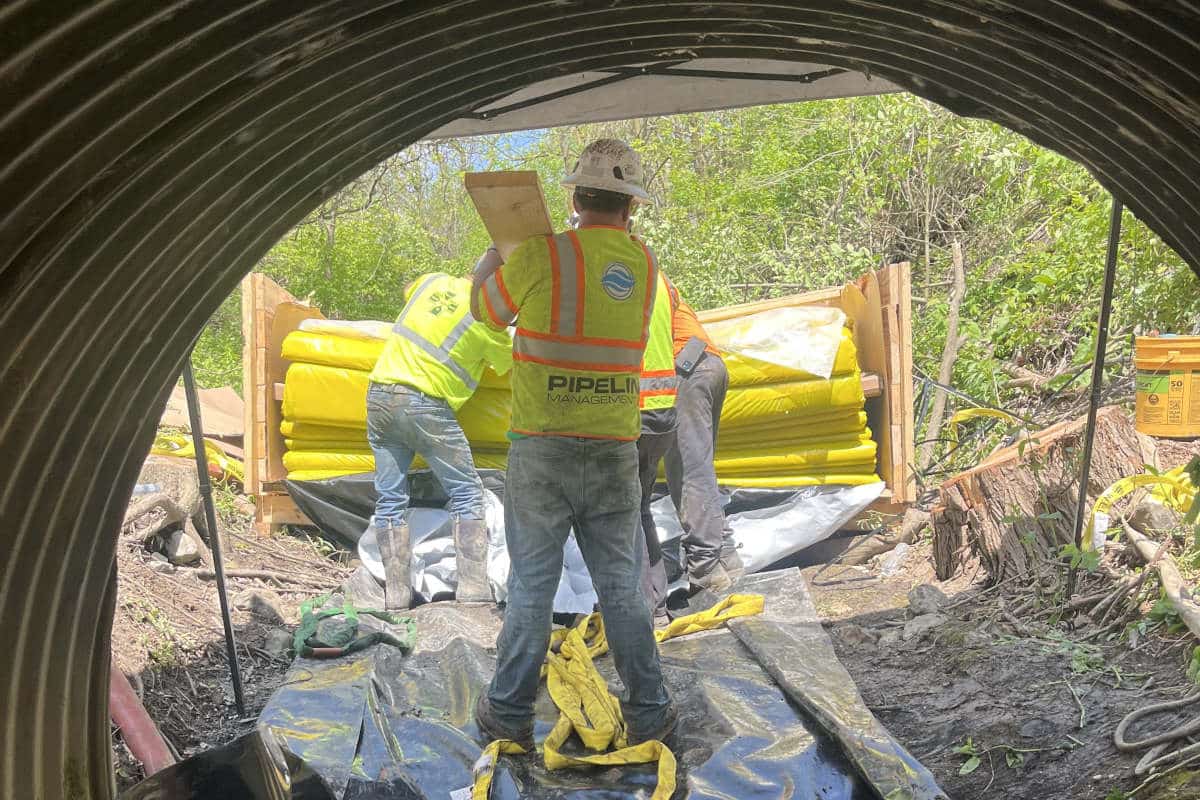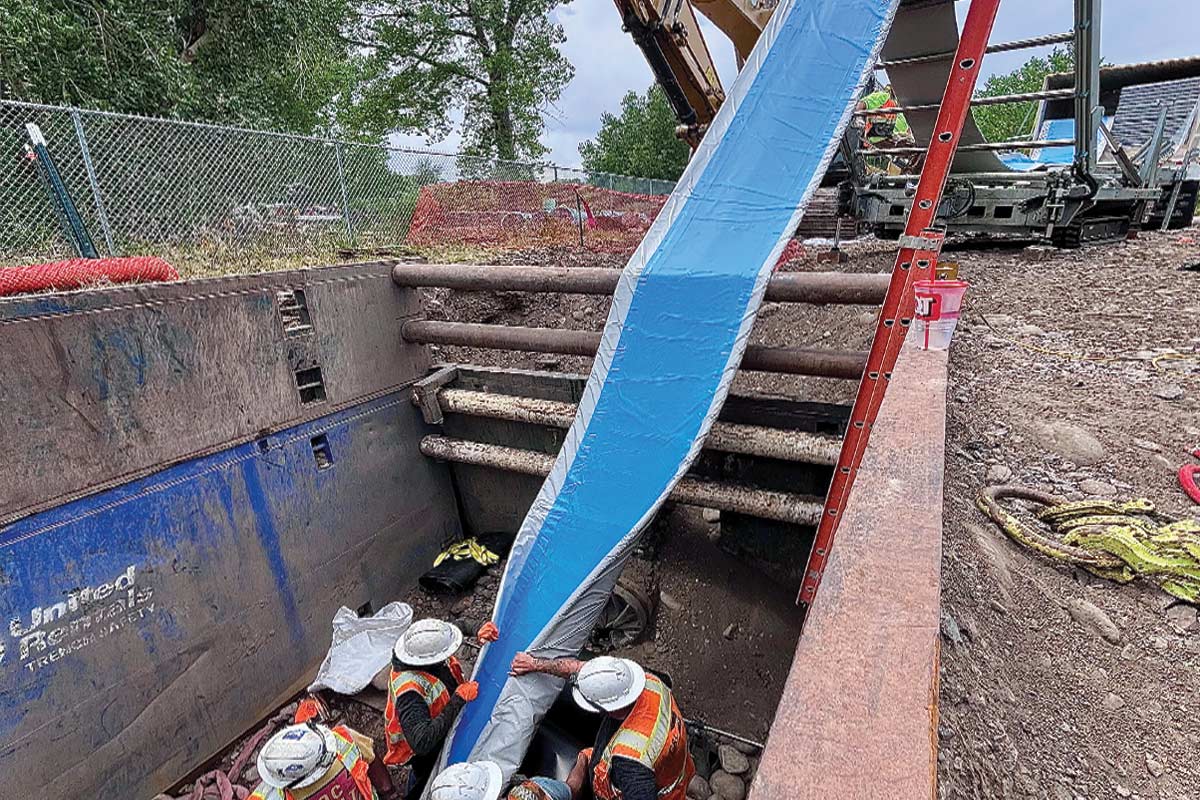
GRP Box Sewer Rehabilitation during the COVID Pandemic
As part of the City of Toronto’s asset management program, many non-circular profile sewers and interceptors are found to be in varying degrees of structural deterioration, as with most North American cities.
One of these such interceptors — the High Level Interceptor (HLI) — was a rectangular shaped sewer that was built in 1910. The interceptor sewer dimensions are 8 ft by 10 ft and carries most of the City’s sewerage before the Ashbridges Bay Sewerage Treatment Plant. At flow ratings of around 1,000 liters per second in dry weather conditions, the interceptor is a critical part of the collector system.
The box structure was inspected in 2018 and was found to be in less than desirable condition, so the decision was made to rehabilitate the structure using trenchless methods, due to the location in a busy part of Downtown Toronto.
The pipe section between MH 101-003 and MH 101-002 was found to be in overall in fair to poor condition with multiple structural defects, including holes, fractures and exposed rebars observed. A comparison between the subsequent CCTV inspections taken several years apart suggests that the rate of deterioration of the in the sewer is increasing. Most defects observed are in the crown region of the trunk.
RELATED: Toronto Spray-applied Project Requires Additional Attention
Several different trenchless methods were evaluated as potential solutions for the design of the rehabilitation, however due to the hydraulic requirements, a glass reinforced plastic (GRP) segmental panel lining system was found to be the best option. The recommended rehabilitation method for the section of the HLI between MH 101-003 and the proposed HLI diversion chamber was sliplining in controlled flow utilizing GRP liner sections, designed to withstand hydrostatic pressure, geostatic pressure and applicable live loads.

GRP liner is capable of providing a structural solution, withstanding geostatic and hydrostatic loads, as well as live loads. Post- rehabilitation scenarios utilizing the GRP liner provided adequate capacity for the modeled dry and wet weather flows.
Also, a cost-saving opportunity was identified by coordinating the proposed rehabilitation of the HLI with another construction project of the HLI diversion chamber (part of the Integrated Pumping Station upgrade). The construction shaft for the diversion chamber was used as the jacking shaft for the relining work.
Furthermore, with flows as high as 3,000 liters per second due to high groundwater and high lake water level, it was beneficial to deploy a lining methodology that allows the flow to enter the channel during wet weather flow events. This strategy, combined with the utilization of an upstream diversion to the MTI, enable to complete the work utilizing a moderate 600 liters per second mechanical bypass, resulting in significant cost saving. Post-rehabilitation scenarios utilizing the GRP liner provided adequate capacity for the modeled dry and wet weather flows.
The tender package was designed and issued in August 2020 — five months into the COVID-19 pandemic. The bid package, Rehabilitation of the High Level Interceptor from MH101-003 to Ashbridges Bay Wastewater Treatment Plant was a Design, Bid, Build Tender with strict terms for contractor experience due to the sensitive location and installation methods needed to complete the project.
RELATED: GRP Panel Lining in Bogotá, Colombia
The qualified, low bid contractor was Capital Sewer Services based out of Vaughan, Ontario, which has completed many GRP lining projects dating back to the mid-2000s; hence were a perfect fit as they are able to perform all aspects of the project in-house.
Following the project award, one of the initial phases was obtaining permits to use a local park as the staging and insertion area at the upstream end of the project. This proved to be challenging as the park was home to a long-standing Saturday Farmers Market that had to be temporarily relocated without adversely affecting the market vendors’ revenue. Capital Sewer Services negotiated directly with the Farmers Association to find a mutually agreeable temporary location.
In addition to this, and taking into account that most of Canada was in COVID shutdown/stay-at-home mode, the contractor had to take into account that the park was one of the only sources of recreation for residents. Hence, the construction footprint, which should have been a full park takeover, was cut down dramatically to allow the residents to maintain use of some of the area.
Delays in mobilization were experienced due to HLI Diversion Chamber project falling behind schedule.
Capital Sewer Services chose Channeline International Fibreglass Mfg. to design and manufacture the Structural GRP Lining System for the HLI. Channeline has nearly 40 years of experience in manufacturing and supplying non-circular liners and specializes in box-shaped sewer and culvert liners.
Due to initial surveying that showed several pinch points where the existing concrete had deformed, Channeline proposed a 7-ft by 9-ft ID liner with a 1.75 in. wall thickness. The entire liner was 755 ft with a curved section, which was to be factory made.
The flow in the sewer section was then diverted and the box structure cleaned using high-pressure water jetting technology. Once cleaned, a 3D mandrel was manually transported through the existing structure to confirm that the proposed GRP liner sizing was correct and offered the best fit for installation and hydraulic capacity. Although this is simple operation, this step is an integral part of the liner design as it proves that the conceptual sizing of the liner is correct.

The GRP liner order was placed in late September 2021 and production started immediately. The liner took six weeks to manufacture and was shipped in five lots. The first containers started to arrive onsite in early January and were successfully delivered.
Another challenge was that the original design called for a WRc Type 1 Liner Design that requires a 12 MPA (1,760 psi) annulus grout. This grout is not only difficult and laborious to pump into the annular space but due to shortages in raw materials during the pandemic, was almost impossible to source locally. Luckily, between the tendering and construction, the ASCE MOP-145 Design was published, and Channeline were able to reverse engineer the liner design to allow for a fully structural lining system that only requires a minimum 1 MPA (145 psi) strength grout.
RELATED: Pipe Cleaning Contractor Profile: Capital Sewer Services
“During the course of the project there were various challenges and changes that we were able to adapt too. One of the major changes was within the engineering behind the GRP Panels design was originally a Rigid Design Method,” says Tyler Leeming, senior project manager at Capital Sewer Services. “Channeline was able to provide new design per ASCE MOP-145. We were able to provide a better solution and a design that fit this project due to Channeline’s team of engineers.
“Using this design approach we were able to change the requirement for annular grouting, which allowed us to use an 800 Kg/m3 cellular grout to fill the annulus. This design approach satisfied the requirements within the contract and allowed for a much more productive grout pour.”
During this time it was taken into account that the delays would take the project into the spring thaw and rain season, with the potential danger of sewer surcharge at the open access pits. In the interest of safety, Capital Sewer Services arranged for the weir walls to be raised approximately 1 m above the surface to counter any surcharge.
Once all of the lining materials were delivered, Capital Sewer Services crews mobilized an army to site and were able to install the liner in just five shifts. Bulkheads were then installed at each end of the liner and annulus grouting was completed in another five days. The grouting was self-performed by Capital Sewer Services, and entailed more than 49 ready mix trucks supplying the grout.
Andy Sherwin is the technical sales director for North America at Channeline International.




